

Medical research. Medical robots in action: Ivar Mendez at TEDxToronto. The Da Vinci Robot on The Late Late Show, Ireland's most popular and prestigious television show and is the longest running chat show in the world. Building Medical Robots, Bacteria sized: Bradley Nelson at TEDxZurich. Robot treats brain clots with steerable needles. Robot Surgeons are the Future of Medicine. Robotics. New technology. Researchers. New research. Medical Robotics. Medical research. Surgical robots to provide open-source platform for medical robotics research. January 12, 2012 In a basement on the University of Washington campus perch seven identical robots.
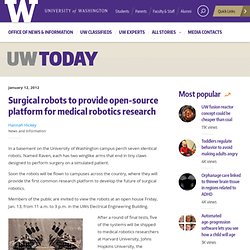
Named Raven, each has two winglike arms that end in tiny claws designed to perform surgery on a simulated patient. Soon the robots will be flown to campuses across the country, where they will provide the first common research platform to develop the future of surgical robotics. Members of the public are invited to view the robots at an open house Friday, Jan. 13, from 11 a.m. to 3 p.m. in the UWs Electrical Engineering Building. Three of the seven Raven II robots. Medical Robotics. Professor Guang-Zhong Yang discussing medical robotics with Dr George Mylonas Research in surgical robot has an established track record at Imperial College London and a number of research and commercial surgical robot platforms have been developed over the years.
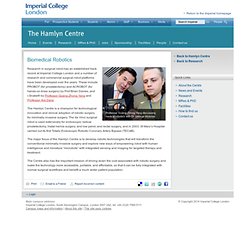
These include PROBOT (for prostatectomy) and ACROBOT (for hands-on knee surgery) by Prof Brian Davies, and i-Snake® by Professor Guang-Zhong Yang and Professor Ara Darzi. The Hamlyn Centre is a champion for technological innovation and clinical adoption of robotic surgery for minimally invasive surgery. Robotics Institute Research Guide : Medical Robotics. In the area of Medical Robotics, current projects at RI span basic and applied research in multiple areas, including: 1.
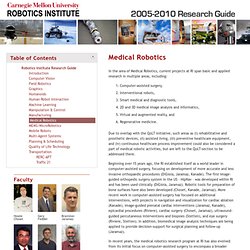
Computer-assisted surgery,2. Interventional robots,3. Smart medical and diagnostic tools,4. 2D and 3D medical image analysis and informatics,5. Virtual and augmented reality, and 6. Due to overlap with the QoLT initiative, such areas as (i) rehabilitative and prosthetic devices, (ii) assisted living, (iii) preventive healthcare equipment, and (iv) continuous healthcare process improvement could also be considered a part of medical robotic activities, but are left to the QoLT-section to be addressed there. New Da Vinci Xi Surgical Robot Is Optimized for Complex Procedures. Intuitive Surgical's da Vinci series of surgical robots have been conducting FDA-approved minimally invasive surgery on humans for well over a decade now, and the company is continually trying to make its robots better at performing operations with the absolute minimum of cuttingyouopenness.

Last week, Intuitive released a fancy new version of the da Vinci robot, the Xi, which it says has more capabilities than previous models and is optimized for complex procedures. A quick reminder if you're not familiar with the da Vinci: It's not an automated surgical system. Rather, it's remote controlled by a human surgeon. The word "remote" might be a bit misleading, though: while the system is capable of being operated from just about anywhere, it's most common to have the surgeon sitting right next to it, in the operating room with the patient. In case you didn't catch all that, here's the rundown on what's new and improved in the Xi: [ da Vinci Xi ] Robots taking over to help medical research. It has been a long and stealthy takeover, but robots now dominate many leading bioscience laboratories, doing in just hours what once took days or weeks.
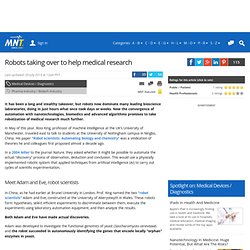
Now the convergence of automation with nanotechnologies, biomedics and advanced algorithms promises to take robotization of medical research much further. In May of this year, Ross King, professor of machine intelligence at the UK's University of Manchester, traveled east to talk to students at the University of Nottingham campus in Ningbo, China. His paper "Robot scientists: Automating biology and chemistry" was a vindication of theories he and colleagues first proposed almost a decade ago. In a 2004 letter to the journal Nature, they asked whether it might be possible to automate the actual "discovery" process of observation, deduction and conclusion.
This would use a physically implemented robotic system that applied techniques from artificial intelligence (AI) to carry out cycles of scientific experimentation. Prof. Prof. Scaling up. 10 Medical Robots That Could Change Healthcare. From microbots that scrape plaque from arteries to personal assistant robots that help care for patients, medical robots are transforming the face of healthcare. 1 of 11 Robots aren't new to healthcare.
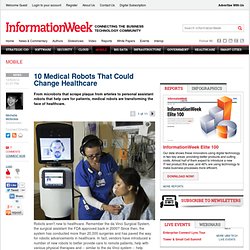
Remember the da Vinci Surgical System, the surgical assistant the FDA approved back in 2000? Since then, the system has conducted more than 20,000 surgeries and has paved the way for robotic advancements in healthcare. In fact, vendors have introduced a number of new robots to better provide care to remote patients, help with various physical therapies and -- similar to the da Vinci system -- help perform surgery. For example, Magnetic Microbots are a group of tiny robots used in various operations, such as removing plaque from a patient's arteries or helping with ocular conditions and disease screenings. And that's no surprise considering the mounting financial difficulties the industry faces.